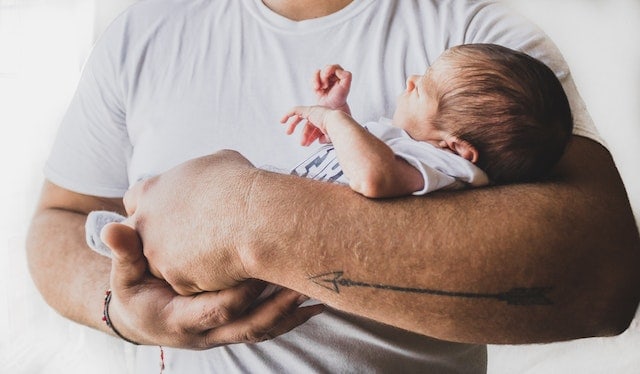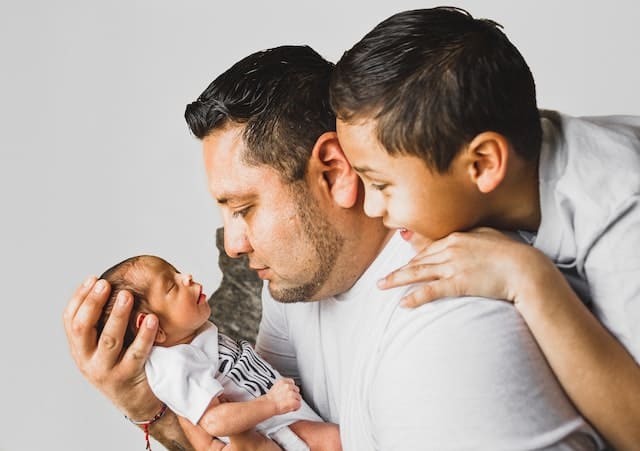Blowing in a baby’s face is a common parenting trick that has been passed down through generations. While it may seem like a simple gesture, there is actually a fascinating science behind it.
This reflexive response in babies, known as the diving reflex, is just one of the many natural reflexes that can be observed in infants.
The diving reflex, also known as the bradycardic response, is an involuntary response in which a baby’s heart rate slows down, and the body redistributes blood flow to essential organs when submerged in water.
However, the reflex can also be triggered by blowing in a baby’s face. Parents often use this technique to help calm a fussy or crying baby. It is important for parents to understand the potential benefits, risks, and concerns related to this practice while also considering alternative methods for soothing a crying infant.
Key Takeaways
- Blowing in a baby’s face can trigger the diving reflex, helping to calm a fussy infant
- Understanding natural reflexes in babies is essential for providing safe and supportive care
- Parents should consider potential risks, such as germs and bacteria, while using this technique
Blowing in Baby’s Face: An Overview

Blowing in a baby’s face is a common parenting trick that has been used for generations. This action triggers an involuntary, instinctive reaction called the diving reflex, which is present in both babies and adults.
When the baby’s face is exposed to a sudden gust of air, their respiratory system temporarily pauses, resulting in a brief moment of physical stillness.
The diving reflex is a natural response that helps babies adapt and survive underwater situations. When the baby’s face is underwater, the reflex tightens the airways and decreases the heart rate, conserving oxygen and reducing water intake.
Although the diving reflex is strongest in infants, it gradually weakens as they grow older.
Another reflex that might get triggered when blowing in a baby’s face is the rooting reflex. This reflex helps babies find their food source (usually a nipple) by turning their head in the direction of the stimulus.
It can be stimulated by touching the baby’s cheek or when the baby feels the air from blowing, which may cause them to turn their head in search of food.
Blowing in a baby’s face is often used by parents to calm their baby down or to distract them during uncomfortable situations, such as administering vaccinations or clipping their nails.
It is essential to exercise care and moderation while employing this technique, using only a gentle puff of air to prevent causing any distress or discomfort to the infant.
In conclusion, blowing in a baby’s face is a useful parenting technique rooted in natural reflexes. While it can serve as an effective calming tool in specific contexts, parents should be mindful of the baby’s wellbeing and avoid overusing this method.
Understanding Babies’ Reflexes
The Diving Reflex
The diving reflex is a survival mechanism seen not just in babies but in all humans. When a baby’s face comes into contact with water or is exposed to a sudden gust of air, such as when you blow in their face, the reflex is triggered.
This response causes the baby to instinctively hold their breath and helps prevent water from entering their airway. The diving reflex also slows down the baby’s heart rate and conserves oxygen, ensuring that vital organs receive enough oxygen during potential underwater submersion.
The Rooting Reflex
The rooting reflex is an important reflex that helps newborn babies search for food. When you touch a baby’s cheek, they automatically turn their head in that direction, opening their mouth and seeking a nipple or feeding source.
This reflex helps babies find their mother’s breast or a bottle, making it easier for them to latch on and start feeding. The rooting reflex typically begins to fade around four months of age as babies develop better head and neck control.
The Startle Reflex
The startle reflex, also known as the Moro reflex, is a response babies exhibit when they feel an unexpected change in their environment, such as a loud noise, sudden movement, or a sensation of falling.
This reflex causes the baby to quickly extend their arms and legs, often with an open hand, and then swiftly bring them back to their body. The startle reflex is present from birth and gradually disappears by four to six months as the baby’s nervous system matures and they gain better control of their limbs.
Why Parents Blow in Babies’ Faces

Calming an Upset or Crying Baby
Blowing in a baby’s face can provide a calming effect, particularly when the baby is upset or crying. The sudden, gentle gust of air triggers their natural reflexes, the dive reflex and the rooting reflex.
This reaction causes a baby to momentarily stop crying and focus on the sensation, granting parents a brief window to calm the hysterical baby and potentially discover the cause of their distress.
Distracting the Baby
Another reason parents might blow in a baby’s face is to provide a mild form of distraction. This tactile diversion can briefly break a cyclical pattern of crying, giving both the baby and the parent some respite.
This technique is especially helpful when a baby is experiencing emotional distress or becoming fixated on a particular sensation or experience. The act of blowing functions as a mild, non-threatening surprise that can quickly redirect the baby’s focus and attention, helping to stop their crying and alleviate some of their upset feelings.
The Calming Effect and Potential Benefits
Influence on the Baby’s Breathing
Gently blowing in a baby’s face can have a calming effect as it triggers a reflex in the baby to hold their breath for a moment. This brief interruption in their breathing pattern can help refocus their attention and may momentarily alleviate distress or discomfort.
The calming effect is most prominent when done gently and with the baby’s best interest in mind.
Remember to be gentle and attentive to the baby’s needs, ensuring that the experience is a positive one. The potential benefits of this technique are more significant when used in combination with other soothing methods, such as gentle touch and calming words.
The Baby Massage Technique
In addition to the calming effect on the baby’s breathing, incorporating a baby massage alongside these techniques can provide further benefits. Baby massage involves using gentle, deliberate strokes to help stimulate the baby’s skin and underlying tissues.
This may help improve the baby’s circulation, digestion, and overall well-being. Moreover, massaging the baby in a calm and relaxed manner can foster a stronger bond between the parent or caregiver and the baby.
When combining these techniques, remember to:
- Be gentle and use a light touch when massaging the baby
- Gauge the baby’s response and adapt the massage accordingly
- Create a calm and soothing atmosphere, such as dimming the lights or playing soft music
- Pay attention to the baby’s cues and respond accordingly to ensure their comfort and happiness
By blending these techniques and considering the baby’s needs, caregivers may notice a reduction in the baby’s stress levels, improved sleeping patterns, and an overall happier demeanor.
Using both blowing in the baby’s face and the baby massage technique can be powerful methods for promoting relaxation and calmness in the baby while enhancing the bond between the baby and caregiver.
Possible Risks and Concerns

Potential Health Risks
Blowing in a baby’s face could pose potential health risks, depending on the circumstances. For instance, if someone with an illness or infection is breathing toward the baby, it could transmit the disease through respiratory droplets.
It is essential to ensure proper hygiene and avoid exposing babies to people with infections.
Additionally, forcefully blowing air into a baby’s face might accidentally introduce foreign particles or substances, like dust, into their eyes or respiratory system, potentially leading to irritation or infection.
Uncomfortable and Discomfort
While some babies may find being blown in the face somewhat amusing, others could become uncomfortable and exhibit signs of distress. The sensation of air suddenly hitting their skin could startle them or make them feel uneasy, particularly if they are sensitive to sensory stimuli.
In extreme cases, uncomfortable feelings caused by being blown in the face might even lead to physical discomfort for the baby, such as difficulty breathing or coughing.
Frightening the Baby
It is essential to consider the baby’s emotional well-being, as blowing air into their face might frighten or upset them. Unexpected gusts of air could startle the baby, leading to anxiety or fear, which could manifest as crying or agitation.
Always observe your baby’s cues and reactions closely when trying new activities or interactions. If they appear uncomfortable or scared, it is best to refrain from continuing the action to ensure their emotional well-being.
Germs, Bacteria, and the Immune System
Babies are constantly exposed to various germs and bacteria, which play a significant role in the development of their immune system. By coming into contact with these potentially harmful agents, a baby’s immune system learns how to recognize and effectively combat them.
Blowing in a baby’s face can potentially introduce germs and bacteria present in the caregiver’s breath. While exposure to a diverse range of microorganisms is necessary for immune system development, it is crucial to maintain a balance.
Excessive exposure to harmful agents can lead to infections and illnesses in young babies.
It is important to consider factors such as the overall health of the caregiver and the environment when assessing the risk of germ transmission. A healthy immune system in the caregiver may translate to minimal germs in their breath, reducing the risk.
However, a sick caregiver may inadvertently introduce potentially harmful germs and bacteria to the baby. In such cases, it is advisable for the caregiver to wear a mask or avoid close contact with the baby.
Cleanliness in the baby’s surroundings also impacts the risk of germ transmission. Regularly disinfecting surfaces in the baby’s environment, washing hands before handling the baby, and ensuring proper overall hygiene can significantly reduce the risk of infections.
In conclusion, blowing in a baby’s face may expose them to germs and bacteria that can impact their immune system development, but it is important to weigh the risks and benefits. Caregivers should be cautious about their health and hygiene to minimize the potential for harmful exposure.
Alternative Ways to Soothe a Crying Baby
Cuddling the Baby
One way to help calm a crying baby is by cuddling them. Holding the baby close to the caregiver’s body can provide comfort and a sense of safety. This physical touch helps promote a feeling of security, which can be beneficial in soothing a crying baby.
Different holding positions may be more effective for individual babies, so caregivers should experiment with various methods to see what works best for their child.
Feeding the Baby
Another effective approach to calming a crying baby is feeding them. It is essential to determine if the baby is hungry by observing their behavior and ensuring a proper feeding schedule. A healthy feeding routine can help prevent excessive crying and maintain the infant’s overall well-being.
However, it is crucial not to overfeed the baby, as this may lead to discomfort and increased crying. Monitoring feeding times and amounts can assist caregivers in addressing their baby’s needs effectively.
Conclusion
In conclusion, blowing gently in a baby’s face can be a safe and healthy practice when done appropriately. Parents should always be gentle when engaging with this activity to avoid any potential harm to the baby.
Being knowledgeable about the proper technique and understanding the baby’s cues can foster a positive experience for both the parent and child.
It is important to remember that while this activity might have some benefits, such as improving a baby’s breathing pattern or providing a source of playfulness, it should never be done with force or in an intimidating manner.
Keeping the experience light and enjoyable for the baby can help strengthen the bond between the parent and child, ultimately contributing to the child’s emotional wellbeing.
In the end, parents who choose to engage in this activity should be confident in their ability to do it safely, and always consider their baby’s individual needs and reactions. By practicing these guidelines, blowing in a baby’s face can be an interesting, harmless, and fun activity to share with their little ones.
Frequently Asked Questions
Why do babies hold their breath when the wind blows on their face?
Babies hold their breath when the wind blows on their face due to the diving reflex, also known as the bradycardic response. This is an involuntary reaction that helps to protect them from water and other external factors.
When a baby’s face comes in contact with cold air or water, the reflex causes the baby to hold their breath, slow their heart rate, and redirect blood flow to vital organs for survival.
Does blowing in a baby’s face help with congestion?
Blowing in a baby’s face can help stimulate the dive reflex, which could assist in clearing their airways temporarily. The sudden gust of air might encourage the baby to take a deep breath or cough, helping to remove mucus from their nasal passages.
However, it’s essential to be gentle and consult with a pediatrician for proper guidance on dealing with congestion.
What is the reason for the baby diving reflex?
The baby diving reflex is an innate survival mechanism, primarily designed to protect young infants when submerged in water. This reflex helps babies hold their breath, decrease their heart rate, and conserve energy when exposed to cold or wet conditions.
The diving reflex also works as a defense mechanism when encountering other environmental stressors, such as strong winds.
At what age does the dive reflex disappear in infants?
The diving reflex diminishes as a child grows, usually fading between the ages of 6 months to 1 year. As infants develop and gain more control over their respiratory and motor functions, the reflex becomes less pronounced.
However, in some individuals, the reflex may persist in a milder form even beyond their infancy years.
Why does blowing on a baby’s face help calm them?
Blowing on a baby’s face may help calm them by triggering the dive reflex, which can result in slowed heart rate and relaxed muscles. This response may create a soothing effect and distract the baby from the source of distress.
Additionally, the gentle sensation on their face might also provide a comforting and calming experience.
What could cause a baby to make a gasping sound?
A baby may make a gasping sound for various reasons, such as congestion, reflux, or an immature respiratory system. Usually, these sounds are harmless and resolve as the baby matures. However, persistent or severe gasping could be a sign of a respiratory issue or other health concern.
In such cases, consulting a pediatrician is advised.

Iesha is a loving mother of 2 beautiful children. She’s an active parent who enjoys indoor and outdoor adventures with her family. Her mission is to share practical and realistic parenting advice to help the parenting community becoming stronger.
